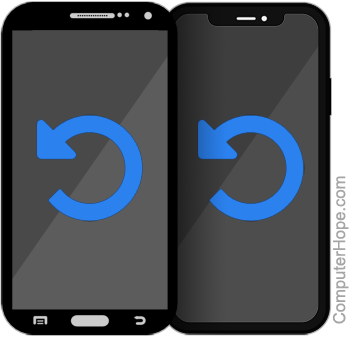How to reset a smartphone to factory settings

Resetting or restoring a smartphone to factory settings helps fix multiple problems, including if you forgot your passcode, or if there are operating system or app problems. The process to reset a smartphone depends on the type of smartphone. Choose the type of smartphone you have from the list below and follow the steps to reset it to factory settings.
Resetting your smartphone to the factory settings erases all data, including your contact list, music, personal data, and texts.
Android smartphone

There are many different brands and models of Android smartphones, so the reset option can differ some between each one. The main difference in the reset procedure is whether the smartphone has a stock version of the Android operating system or a modified version. Most brands of Android smartphones have a stock version of Android, but Samsung uses a modified version of Android on their smartphones.
Below are the most common ways to reset an Android smartphone, with steps for smartphones with stock Android and for Samsung smartphones.
Reset through the Settings menu (stock Android)
- Find and tap the Settings icon on the Home screen or in the app drawer.
- Scroll down to the bottom of the Settings screen and tap the System option.
- Tap Reset options.
- Tap the Erase all data (factory reset) option.
- Scroll down to the bottom of the Erase all data screen and tap the Reset phone option.
- If prompted, enter your device password or PIN (personal identification number), then tap Continue.
- Tap the Erase everything option to begin the reset process.
Reset through the Settings menu (Samsung)
- Find and tap the Settings icon on the Home screen or in the app drawer.
- Scroll down to the bottom of the Settings screen and tap the System option.
- Tap the General management option.
- Tap the Reset option.
- Tap the Factory reset data option.
- Scroll down to the bottom of the Factory Reset Data screen and tap the blue Reset option.
- If prompted, enter your device password or PIN, then tap Next.
- Tap the Delete all option to begin the reset process.
Reset through Recovery mode (stock Android)
- Turn off your smartphone.
- Press and hold the Power button and Volume down button until you see a screen with a list of options.
- Use the Volume buttons to scroll to the Recovery mode option, then press the Power button to select that option.
- The phone will restart and reload to a screen that says "No command." Press and hold the Power button and Volume up button until the Recovery mode screen is displayed.
- Use the volume buttons to scroll to the Wipe data/factory reset option, then press the Power button to select that option.
- Select the Yes option using the Power button to start the reset process.
- After the reset process completes, use the Power button to select the Reboot system now option on the Recovery mode screen.
Reset through Recovery mode (Samsung)
- Turn off your smartphone.
- Press and hold the Volume up button and Power button until you see the "Installing system update" screen.
- When you see the "No command" screen, wait about 10 to 15 seconds for the phone to start recovery mode.
- Use the Volume buttons to scroll to the Wipe data/factory reset option, then press the Power button to select that option.
- Select the Yes option using the Power button to start the reset process.
- After the reset process completes, use the Power button to select the Reboot system now option on the Recovery mode screen.
iPhone

To reset an iPhone, select a link below for the model of iPhone you have and follow the steps.
iPhone 12
If you are restoring the iPhone to sell, donate, or dispose of it, and you have a new iPhone you plan to use, follow these steps first. Otherwise, skip to the factory restore steps.
- Open the Settings app.
- On the Settings screen, access the Apple ID settings by tapping your name at the top of the screen.
- On the Apple ID screen, scroll to the bottom and tap Sign Out.
- Enter your Apple ID password and tap Sign Out again. The iPhone should log out of your Apple ID account and disable Find My iPhone.
- On your new iPhone, open the Settings app and access the Apple ID settings by tapping your name at the top of the screen.
- On the Apple ID screen, scroll to the bottom. Above the Sign Out option, the devices connected to your Apple ID are listed. Tap the name of your old iPhone, and then tap Remove from Account at the bottom of the Device Info screen.
To restore your iPhone to factory settings, follow the steps below.
- Open the Settings app.
- On the Settings screen, tap the General option.
- Scroll to the bottom of the General screen and tap Reset.
- Tap the Erase All Content and Settings option on the Reset screen.
- Enter your passcode, if prompted.
- Tap Erase iPhone to start the factory restore.
- If prompted, tap Erase iPhone again.
iPhone 11 and earlier models
If you are restoring your iPhone to sell, donate, or dispose of it, and you have a new iPhone you plan to use, follow these steps first. Otherwise, skip to the factory restore steps.
- Open the Settings app.
- On the Settings screen, access the Apple ID settings by tapping your name at the top of the screen.
- On the Apple ID screen, scroll to the bottom and tap Sign Out.
- Enter your Apple ID password and tap Sign Out again. The iPhone should log out of your Apple ID account and disable Find My iPhone.
- On your new iPhone, open the Settings app and access the Apple ID settings by tapping your name at the top of the screen.
- On the Apple ID screen, scroll to the bottom. Above the Sign Out option lists devices connected to your Apple ID. Tap the name of your old iPhone, and then tap Remove from Account at the bottom of the Device Info screen.
To restore your iPhone to factory settings, select a restore method and follow the steps.
Restore through iPhone Settings app
- Open the Settings app.
- On the Settings screen, tap the General option.
- Scroll to the bottom of the General screen and tap Reset.
- Tap the Erase All Content and Settings option on the Reset screen.
- Enter your passcode, if prompted.
- Tap Erase iPhone to start the factory restore.
- If prompted, tap Erase iPhone again.
Restore through iTunes
- Connect your iPhone to a computer and open the iTunes application on that computer.
- Force restart the iPhone.
- iPhone 8, iPhone X, iPhone 11: Press and release the Volume Up button. Press and release the Volume Down button. Press and hold the Side button until the recovery mode screen is displayed.
- iPhone 7: Press and hold the Volume Down and Side button until the recovery mode screen is displayed.
- iPhone 6: Press and hold the Home button and the Top button until the recovery mode screen is displayed.
- In the iTunes application on the computer, a window should appear with Restore and Update options. Click the Restore button to restore the iPhone.
iPhone factory restore troubleshooting
If you are restoring your iPhone through iTunes, you may encounter the following error in iTunes.
The iPhone "iPhone" could not be restored. An unknown error occurred (4010).
If you encounter this error, try the following options to resolve the issue and successfully restore your iPhone.
- Make sure the latest version of iTunes is installed on your computer. On a Mac computer, iTunes should automatically update when Apple releases new updates. On a Windows computer, download the latest version of iTunes from the Microsoft Store.
- Connect the iPhone-to-computer USB cable to a different USB port on the computer. If the USB cable connects to a front or top panel port, try connecting it to the back of the computer.
- Temporarily disable the Windows Defender Firewall. The firewall may be blocking communication to Apple servers, and may also block some communication between iTunes and the iPhone.
- Temporarily disable the antivirus program running on your computer. Antivirus programs can sometimes interfere with communication between iTunes and the iPhone.
